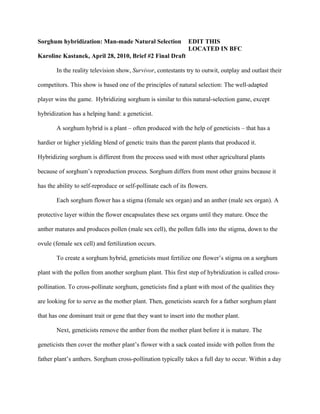
Man-made Natural Selection: Sorghum Hybridization
- 1. Sorghum hybridization: Man-made Natural Selection EDIT THIS LOCATED IN BFC Karoline Kastanek, April 28, 2010, Brief #2 Final Draft In the reality television show, Survivor, contestants try to outwit, outplay and outlast their competitors. This show is based one of the principles of natural selection: The well-adapted player wins the game. Hybridizing sorghum is similar to this natural-selection game, except hybridization has a helping hand: a geneticist. A sorghum hybrid is a plant – often produced with the help of geneticists – that has a hardier or higher yielding blend of genetic traits than the parent plants that produced it. Hybridizing sorghum is different from the process used with most other agricultural plants because of sorghum’s reproduction process. Sorghum differs from most other grains because it has the ability to self-reproduce or self-pollinate each of its flowers. Each sorghum flower has a stigma (female sex organ) and an anther (male sex organ). A protective layer within the flower encapsulates these sex organs until they mature. Once the anther matures and produces pollen (male sex cell), the pollen falls into the stigma, down to the ovule (female sex cell) and fertilization occurs. To create a sorghum hybrid, geneticists must fertilize one flower’s stigma on a sorghum plant with the pollen from another sorghum plant. This first step of hybridization is called cross- pollination. To cross-pollinate sorghum, geneticists find a plant with most of the qualities they are looking for to serve as the mother plant. Then, geneticists search for a father sorghum plant that has one dominant trait or gene that they want to insert into the mother plant. Next, geneticists remove the anther from the mother plant before it is mature. The geneticists then cover the mother plant’s flower with a sack coated inside with pollen from the father plant’s anthers. Sorghum cross-pollination typically takes a full day to occur. Within a day
- 2. of putting the sack over the mother plant’s flower, its stigma emerges; pollen on the sack falls into the stigma, and the reproductive process begins. Geneticists usually cross-pollinate at least five flowers with the same father plant. The result of this process is an F1 (first generation) hybrid seed. Sounds simple, right? It’s not so easy, said Ismail Dweikat, a University of Nebraska- Lincoln INTSORMIL scientist. Dweikat hybridizes sorghum to be more adaptable to growing conditions in Africa. He develops sorghum varieties that can withstand the cool weather and that can store and use nitrogen more efficiently. In addition, he breeds sorghum varieties to have larger seeds. Dweikat said that increasing the size of the seed helps African farmers sift rocks and sand out of it. Some farmers also benefit from the seed’s larger size because it is big enough to be sown with a planter used to sow larger grains like maize. The hybridization process is long and tedious. Scientists cross-pollinate at least five sorghum flowers with the same pollen. Then once the flowers are cross-pollinated and mature into seeds, scientists plant them. Scientists determine which of the five seeds grown into plants has the best blend of genes in its seeds and marks that seed as the F1 seed. Usually, 50 percent of the male genes are blended with 50 percent of the female genes in the F1 seed. This is similar to a child receiving half of his or her genes from one parent the other half from the other parent. The difference between human reproduction and hybridization is that Dweikat is looking for only one gene to transfer from the father plant to the F1 seed. So, he plants the F1 seed and then crosses its flowers with pollen from the same sorghum variety as its mother plant, a process called back-crossing plants. Dweikat then sorts the cross-pollinated seeds (F2 seeds), examining the traits of each new seed and saving the seed with the most qualities he’s looking for. He then plants that seed and back-crosses it again with the same variety as the initial mother plant.
- 3. Dweikat repeats this back-crossing and seed-selection process until the hybrid plant has the right combination of qualities. Creating one hybrid typically takes Dweikat at least three to four years, or growing seasons. Hybridization has changed sorghum production in Africa and the U.S. Even though Dweikat may need three to four years to produce just one hybrid, he said, the dividends pay off.